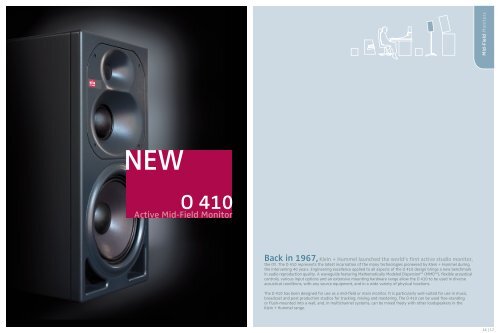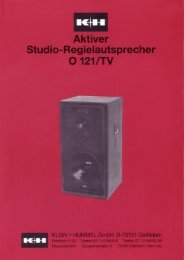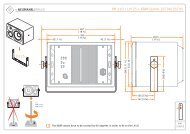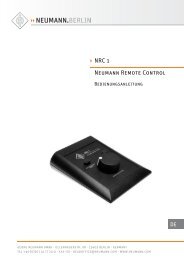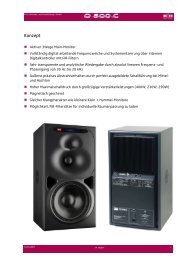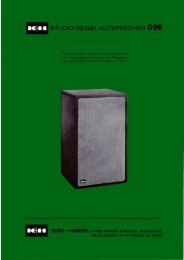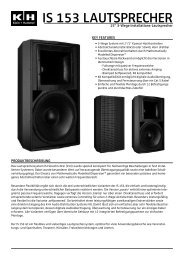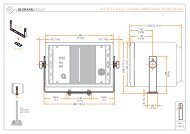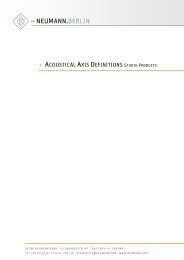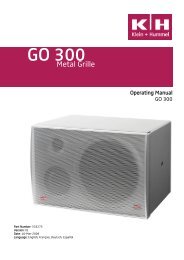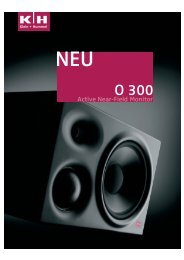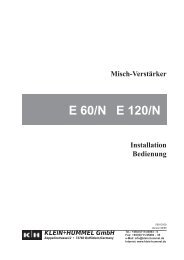Catalog Pages: "Decoding the DNA of Sound" - Klein + Hummel
Catalog Pages: "Decoding the DNA of Sound" - Klein + Hummel
Catalog Pages: "Decoding the DNA of Sound" - Klein + Hummel
Create successful ePaper yourself
Turn your PDF publications into a flip-book with our unique Google optimized e-Paper software.
Mid-Field Monitors<br />
NEW<br />
O 410<br />
Active Mid-Field Monitor<br />
Back in 1967, <strong>Klein</strong> + <strong>Hummel</strong> launched <strong>the</strong> world’s first active studio monitor,<br />
<strong>the</strong> OY. The O 410 represents <strong>the</strong> latest incarnation <strong>of</strong> <strong>the</strong> many technologies pioneered by <strong>Klein</strong> + <strong>Hummel</strong> during<br />
<strong>the</strong> intervening 40 years. Engineering excellence applied to all aspects <strong>of</strong> <strong>the</strong> O 410 design brings a new benchmark<br />
in audio reproduction quality. A waveguide featuring Ma<strong>the</strong>matic ally Modeled Dispersion (MMD), flexible acoustical<br />
controls, various input options and an extensive mounting hardware range allow <strong>the</strong> O 410 to be used in diverse<br />
acoustical conditions, with any source equipment, and in a wide variety <strong>of</strong> physical locations.<br />
The O 410 has been designed for use as a mid-field or main monitor. It is particularly well-suited for use in music,<br />
broadcast and post production studios for tracking, mixing and mastering. The O 410 can be used free-standing<br />
or flush-mounted into a wall, and, in multichannel systems, can be mixed freely with o<strong>the</strong>r loudspeakers in <strong>the</strong><br />
<strong>Klein</strong> + <strong>Hummel</strong> range.<br />
16 | 17
Frequency response<br />
THD at 95 dB SPL at 1 m 2 nd 3 rd<br />
large user-rotatable<br />
waveguide<br />
hybrid class A-B / H<br />
amplifiers<br />
informative display<br />
can be dimmed for low<br />
ambient light and behind<br />
<strong>the</strong> screen applications<br />
dB<br />
90<br />
80<br />
70<br />
dB<br />
– 10<br />
– 20<br />
– 30<br />
– 40<br />
– 50<br />
– 60<br />
O 410 Mid-Field Monitor<br />
large ports minimize<br />
turbulence, resulting in<br />
reduced bass compression<br />
and chuffing noises<br />
Mid Sized 3-way System<br />
Q The most important part <strong>of</strong> <strong>the</strong> frequency spectrum is reproduced by a separate midrange driver<br />
Q Extremely low harmonic and intermodulation distortion results in clean sounding audio reproduction<br />
Q Exceptionally neutral sound stage from 30 Hz to 24 kHz (– 3 dB)<br />
Q Ideal cabinet materials with excellent self-damping properties<br />
Q Structural resonances avoided using LRIM (Low Resonance Integral Molding)<br />
Q Vented enclosure extends bass response, even at very high output<br />
Q Modern-looking design with optional grille<br />
Q Extensive accessories allow for a multitude <strong>of</strong> installation possibilities<br />
Q Magnetically shielded for use next to CRT screens<br />
Ma<strong>the</strong>matically Modeled Dispersion (MMD)<br />
Q Three stage design process:<br />
A Waveguide is ma<strong>the</strong>matically modeled before physical prototypes are realized<br />
A Physical prototypes are measured under anechoic conditions to verify <strong>the</strong>oretical performance<br />
A Extensive listening tests correlate objective measurements and subjective perception<br />
Q Wide horizontal directivity gives increased freedom <strong>of</strong> movement along <strong>the</strong> mixing console<br />
Q Narrow vertical directivity reduces <strong>the</strong> effect <strong>of</strong> early reflections <strong>of</strong>f <strong>the</strong> console surface<br />
Q MMD is easily rotated in <strong>the</strong> field when horizontal mounting <strong>the</strong> cabinet<br />
Q Perfect directivity pattern leads to a smooth power response<br />
Advanced Electronics<br />
Q Transformer balanced input stage (TIM 1) equipped with special distortion reduction crossover function<br />
Q 16...24-Bit, 20...216 kHz digital input stage (DIM 1) for AES3, AES 3id and S/P-DIF signals<br />
Q Electronics can be remotely accessed when <strong>the</strong> cabinet is flush mounted (REK 1 and CP 2, 5, 10, 15, 20, 25, or 30)<br />
Q Integrated electronic limiter for each driver<br />
Q Hybrid class A-B amplifiers, employed for <strong>the</strong>ir best overall performance, are also protected<br />
Q Active three-way crossover with 24 dB/oct. slopes<br />
Q Input options give flexibility without burdening basic product:<br />
A Transformer balanced input stage equipped with special distortion reduction crossover function<br />
A 16…24-bit, 20…216 kHz digital input stage for AES3, AES 3id and S/P-DIF signals<br />
A XLR and BNC inputs, and a BNC output for flexible and robust interconnectivity<br />
Q Display for signal type, protect and digital status is integrated into <strong>the</strong> MMD, toge<strong>the</strong>r with a K+H logo<br />
Q Controls adapt <strong>the</strong> monitor’s response to compensate for <strong>the</strong> loudspeaker’s environment:<br />
A Bass, mid and treble controls for specific and common acoustical issues<br />
A Parametric EQ for low-frequency corrections<br />
Q Accelerated Heat Tunneling (AHT) ensures effective amplifier cooling whe<strong>the</strong>r <strong>the</strong> cabinet is mounted<br />
vertically or horizontally<br />
Q Electronics can be remotely accessed when <strong>the</strong> cabinet is flush mounted<br />
Q Electronics can be remotely powered on with two modes <strong>of</strong> operation (0 V and 12 V trigger)<br />
Q Attention to detail in design results in low self-generated noise<br />
0.05 0.2 0.5 1 2 5 10 kHz<br />
Group delay<br />
0.05 0.2 0.5 1 2 5 10 kHz<br />
Horizontal directivity<br />
125 250 500 1,000 2,000 4,000 8,000 16,000<br />
f[Hz]<br />
60<br />
50<br />
ms<br />
20<br />
0<br />
–20<br />
90<br />
60<br />
30<br />
0 degree<br />
– 30<br />
– 60<br />
– 90<br />
– 90<br />
0.05 0.2 0.5 1 2 5 kHz<br />
Multitone distortion O 410 at 95 dB SPL at 1 m<br />
Acoustical controls Parametric equalizer<br />
dB<br />
0<br />
– 10<br />
– 20<br />
– 30<br />
– 40<br />
0.05 0.2 0.5 1 2 5 10 kHz<br />
0.05 0.2 0.5 1 2 5 10 kHz<br />
Vertical directivity<br />
– 70<br />
– 80<br />
125 250 500 1,000 2,000 4,000 8,000 16,000<br />
f[Hz]<br />
dB<br />
0<br />
– 5<br />
– 10<br />
– 15<br />
0.001 0.1 1 kHz<br />
dB<br />
90<br />
80<br />
70<br />
60<br />
50<br />
40<br />
30<br />
20<br />
90<br />
60<br />
30<br />
0 degree<br />
– 30<br />
– 60<br />
– 90<br />
0 to 3 –3 to 0 – 6 to – 3 – 9 to – 6 – 12 to – 9 – 15 to – 12 – 18 to – 15 – 21 to – 18<br />
Decrease <strong>of</strong> SPL (dB)<br />
18 | 19


